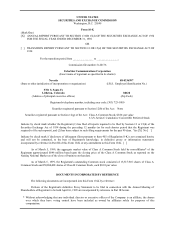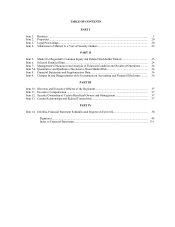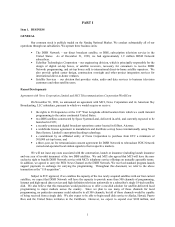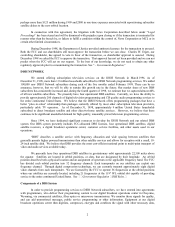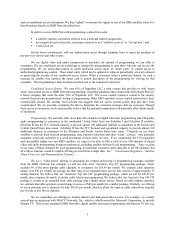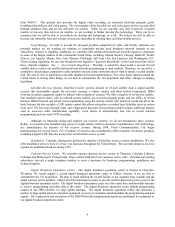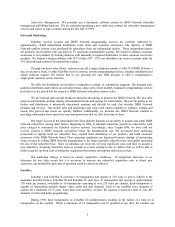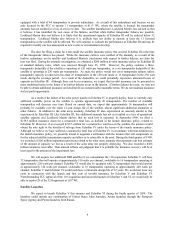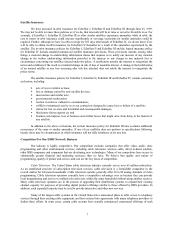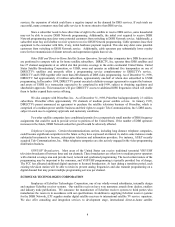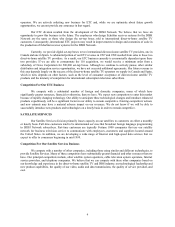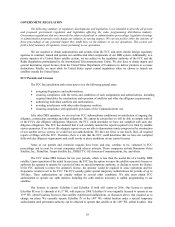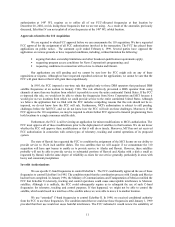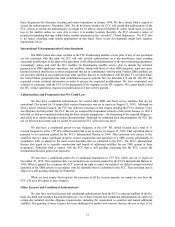Dish Network 1998 Annual Report Download - page 4
Download and view the complete annual report
Please find page 4 of the 1998 Dish Network annual report below. You can navigate through the pages in the report by either clicking on the pages listed below, or by using the keyword search tool below to find specific information within the annual report.2
perhaps more than $125 million during 1999 and 2000 in one-time expenses associated with repositioning subscriber
satellite dishes to the new orbital location.
In connection with this agreement, the litigation with News Corporation described below under “Legal
Proceedings” has been stayed and will be dismissed with prejudice upon closing or if the transaction is terminated for
reasons other than the breach by, or failure to fulfill a condition within the control of, News Corporation or MCI, or in
certain other limited circumstances.
During December 1998, the Department of Justice provided antitrust clearance for the transaction to proceed.
Both the FCC and our shareholders still must approve the transaction before we can close. Charles W. Ergen, our
controlling shareholder, has agreed to vote in favor of the transaction, so shareholder approval is assured. During
December 1998 we asked the FCC to approve the transaction. That approval has not yet been provided and we can not
predict when the FCC will act on our request. To the best of our knowledge, we do not need to obtain any other
regulatory approvals prior to consummating the transaction. See “ – Government Regulation.”
DISH NETWORK
We started offering subscription television services on the DISH Network in March 1996. As of
December 31, 1998, more than 1.9 million households subscribed to DISH Network programming services. We added
100,000 new DISH Network subscribers during each of the five months ended February 1999. There can be no
assurance, however, that we will be able to sustain this growth rate in the future. Our market share of new DBS
subscribers has consistently increased and, during the fourth quarter of 1998, we estimate that we captured almost 40%
of all new satellite subscribers. We presently have four operational DBS satellites. Currently, we have the ability to
provide approximately 200 channels of digital television programming and CD quality audio programming services to
the entire continental United States. We believe that the DISH Network offers programming packages that have a
better “price-to-value” relationship than packages currently offered by most other subscription television providers,
particularly cable TV operators. As of December 31, 1998, approximately 9 million United States households
subscribed to direct broadcast satellite and other direct-to-home satellite services. However, we believe that there
continues to be significant unsatisfied demand for high quality, reasonably priced television programming services.
Since 1994, we have dedicated significant resources to develop the DISH Network and our related DBS
system. Our DBS system presently includes FCC-allocated DBS licenses, four operational DBS satellites, digital
satellite receivers, a digital broadcast operations center, customer service facilities, and other assets used in our
operations.
“DBS” describes a satellite service with frequency allocation and wide spacing between satellites that
generally permits higher powered transmissions than other satellite services and allows for reception with a small, 18-
24 inch satellite dish. We believe that DBS provides the most cost-efficient national point to multi-point transport of
video and audio services available today.
We presently have four operational DBS satellites in geostationary orbit approximately 22,500 miles above
the equator. Satellites are located in orbital positions, or slots, that are designated by their longitude. An orbital
position describes both a physical location and an assignment of spectrum in the applicable frequency band. The FCC
has divided each orbital position into 32 frequency channels. Each transponder on our satellites can exploit one
frequency channel. Through digital compression technology, we can currently transmit approximately eight digital
video channels from each transponder. We are licensed by the FCC to operate 56 frequencies at the orbital positions
where our satellites are currently located, including 21 frequencies at the 119° WL orbital slot capable of providing
service to the entire continental United States. See “ – Government Regulation – DBS Rules.”
Components of a DBS System
In order to provide programming services to DISH Network subscribers, we have entered into agreements
with programmers, who deliver their programming content to our digital broadcast operations center in Cheyenne,
Wyoming, via commercial satellites, fiber optics or microwave transmissions. We monitor those signals for quality,
and can add promotional messages, public service programming or other information. Equipment at our digital
broadcast operations center then digitizes, compresses, encrypts and combines the signal with other necessary data,

